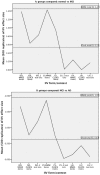Intra-individual variability in Alzheimer's disease and cognitive aging: definitions, context, and effect sizes
- PMID: 21526188
- PMCID: PMC3079725
- DOI: 10.1371/journal.pone.0016973
Intra-individual variability in Alzheimer's disease and cognitive aging: definitions, context, and effect sizes
Abstract
Background/aims: To explore different definitions of intra-individual variability (IIV) to summarize performance on commonly utilized cognitive tests (Mini Mental State Exam; Clock Drawing Test); compare them and their potential to differentiate clinically-defined populations; and to examine their utility in predicting clinical change in individuals from the Alzheimer's Disease Neuroimaging Initiative (ADNI).
Methods: Sample statistics were computed from ADNI cohorts with no cognitive diagnosis, a diagnosis of mild cognitive impairment (MCI), and a diagnosis of possible or probable Alzheimer's disease (AD). Nine different definitions of IIV were computed for each sample, and standardized effect sizes (Cohen's d) were computed for each of these definitions in 500 simulated replicates using scores on the Mini Mental State Exam and Clock Drawing Test. IIV was computed based on test items separately ('within test' IIV) and the two tests together ('across test' IIV). The best performing definition was then used to compute IIV for a third test, the Alzheimer's Disease Assessment Scale-Cognitive, and the simulations and effect sizes were again computed. All effect size estimates based on simulated data were compared to those computed based on the total scores in the observed data. Association between total score and IIV summaries of the tests and the Clinician's Dementia Rating were estimated to test the utility of IIV in predicting clinically meaningful changes in the cohorts over 12- and 24-month intervals.
Results: ES estimates differed substantially depending on the definition of IIV and the test(s) on which IIV was based. IIV (coefficient of variation) summaries of MMSE and Clock-Drawing performed similarly to their total scores, the ADAS total performed better than its IIV summary.
Conclusion: IIV can be computed within (items) or across (totals) items on commonly-utilized cognitive tests, and may provide a useful additional summary measure of neuropsychological test performance.
Conflict of interest statement
Figures

Similar articles
-
Predicting conversion of patients with Mild Cognitive Impairment to Alzheimer's disease using bedside cognitive assessments.J Clin Exp Neuropsychol. 2022 Dec;44(10):703-712. doi: 10.1080/13803395.2023.2167942. Epub 2023 Feb 20. J Clin Exp Neuropsychol. 2022. PMID: 36803664
-
Relationship between the Montreal Cognitive Assessment and Mini-mental State Examination for assessment of mild cognitive impairment in older adults.BMC Geriatr. 2015 Sep 7;15:107. doi: 10.1186/s12877-015-0103-3. BMC Geriatr. 2015. PMID: 26346644 Free PMC article.
-
Intra-individual reaction time variability in mild cognitive impairment and Alzheimer's disease: gender, processing load and speed factors.PLoS One. 2013 Jun 10;8(6):e65712. doi: 10.1371/journal.pone.0065712. Print 2013. PLoS One. 2013. PMID: 23762413 Free PMC article.
-
Going beyond the mean: Intraindividual variability of cognitive performance in prodromal and early neurodegenerative disorders.Clin Neuropsychol. 2019 Feb;33(2):369-389. doi: 10.1080/13854046.2018.1533587. Epub 2019 Jan 21. Clin Neuropsychol. 2019. PMID: 30663511 Review.
-
[The new 2011 recommendations of the National Institute on Aging and the Alzheimer's Association on diagnostic guidelines for Alzheimer's disease: Preclinal stages, mild cognitive impairment, and dementia].Rev Neurol (Paris). 2012 Jun;168(6-7):471-82. doi: 10.1016/j.neurol.2011.11.007. Epub 2012 May 12. Rev Neurol (Paris). 2012. PMID: 22579080 Review. French.
Cited by
-
Increased intraindividual variability (IIV) in reaction time is the earliest indicator of cognitive change in MS: A two-year observational study.Int J Clin Health Psychol. 2024 Jul-Sep;24(3):100486. doi: 10.1016/j.ijchp.2024.100486. Epub 2024 Jul 13. Int J Clin Health Psychol. 2024. PMID: 39105175 Free PMC article.
-
Cognitive Intra-individual Variability in HIV: an Integrative Review.Neuropsychol Rev. 2022 Dec;32(4):855-876. doi: 10.1007/s11065-021-09528-x. Epub 2021 Nov 26. Neuropsychol Rev. 2022. PMID: 34826006 Free PMC article. Review.
-
Within-Individual Variability: An Index for Subtle Change in Neurocognition in Mild Cognitive Impairment.J Alzheimers Dis. 2016 Aug 10;54(1):325-35. doi: 10.3233/JAD-160259. J Alzheimers Dis. 2016. PMID: 27567827 Free PMC article.
-
New onset, transient and stable motoric cognitive risk syndrome: Clinical characteristics and association with incidence of probable dementia in the NuAge cohort.Front Aging Neurosci. 2023 Jan 19;14:1063702. doi: 10.3389/fnagi.2022.1063702. eCollection 2022. Front Aging Neurosci. 2023. PMID: 36742207 Free PMC article.
-
Does cognitive intra-individual variability predict change in everyday functioning performance in women with and without HIV in the Women's Interagency HIV Study?Appl Neuropsychol Adult. 2024 Dec 24:1-11. doi: 10.1080/23279095.2024.2444573. Online ahead of print. Appl Neuropsychol Adult. 2024. PMID: 39718250
References
-
- Hultsch DF, MacDonald SWS, Hunter MA, Levy-Bencheton J, Strauss E. Intraindividual variability in cognitive performance in older adults: comparison of adults with mild dementia, adults with arthritis, and healthy adults. Neuropsychology. 2000;14(4):588–598. - PubMed
-
- Christensen H, Dear KBG, Anstey KJ, Parslow RA, Sachdev P, et al. Within-Occasion Intraindividual Variability and Preclinical Diagnostic Status: Is Intraindividual Variability an Indicator of Mild Cognitive Impairment? Neuropsychology. 2005;19(3):309–317. - PubMed
-
- Hultsch DF, Strauss E, Hunter MA, MacDonald SWS. Intraindividual variability, cognition, and aging. In: Craik FIM, Salthouse TA, editors. The Handbook of Aging and Cognition, 3E. New York, NY: Psychology Press; 2008. pp. 491–556.
-
- Hultsch DF, MacDonald SWS. Intraindividual variability in performance as a theoretical window onto cognitive aging. In: Dixon RA, Backman L, Nilsson L-G, editors. New Frontiers in Cognitive Aging. New York: Oxford University Press; 2004. pp. 65–88.
-
- Nesselroade JR, Salthouse TA. Methodological and theoretical implications of intraindividual variability in perceptual-motor performance. Journal of Gerontolology, B Psychological Science and Social Science. 2004;59(2):P49–P55. - PubMed
Publication types
MeSH terms
Grants and funding
LinkOut - more resources
Full Text Sources
Medical

